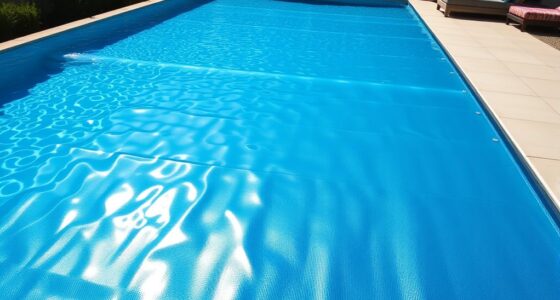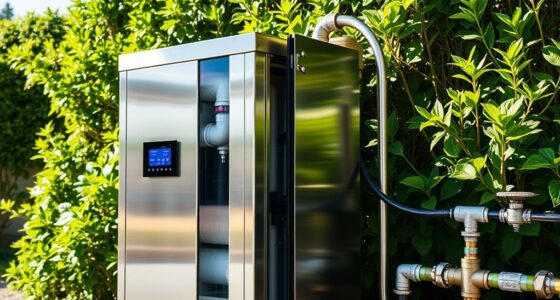If you’re looking to make the most of small rooftop spaces, I recommend exploring the 13 best micro-wind turbines designed for homes and DIY projects. From compact educational models to high-performance turbines, these options improve renewable energy efforts and can power small devices or ventilation systems. They feature durable materials, low wind speed operation, and easy installation. Keep an eye on this list to find the perfect fit for your rooftop, and discover more helpful insights soon.
Key Takeaways
- Offers a range of micro-wind turbines suitable for rooftop installation, from educational models to high-capacity 600W systems.
- Features durable materials like die-cast aluminum and stainless steel, ensuring weather resistance and long-term performance.
- Designed for low wind speeds with high efficiency, ideal for converting small rooftop spaces into reliable energy sources.
- Includes DIY kits and easy-to-install turbines perfect for hobbyists, educators, and small-scale power needs.
- Supports hybrid solar-wind setups and ventilation applications, maximizing energy generation and indoor air quality on rooftops.
1PC AC Motor Vertical Micro Wind Hydraulic Turbines Power Generator Alternator

If you’re looking for an educational micro-wind turbine that’s simple to integrate into small projects or wind tunnel experiments, the PC AC motor vertical micro wind hydraulic turbine is an excellent choice. Its compact size, measuring just 16mm x 13.5mm x 16mm, makes it perfect for demonstrations. The turbine features a permanent magnet motor with 8 silvered plastic blades, providing better rotation at low wind speeds. It produces AC power with a voltage range of 0.01V to 15V and currents up to 0.2A. Rated at 3 m/s wind speed and 3000 rpm, it’s ideal for illustrating wind energy concepts on a small scale.
Best For: educators, students, and hobbyists seeking a simple, small-scale wind energy demonstration tool for experiments and wind tunnel projects.
Pros:
- Compact and lightweight, easy to incorporate into various educational setups
- Produces AC output suitable for demonstrating basic wind-to-electricity conversion
- Low wind speed requirement allows operation in calm environments
Cons:
- Generates limited power, primarily enough for small devices like LEDs
- Efficiency is relatively low due to small blade size and design limitations
- Not suitable for powering larger or high-demand electrical devices
4 Pcs Micro Vertical Wind Turbines for DIY Wind Generator

Looking to build your own wind generator? These 4 pcs micro vertical wind turbines are perfect for DIY projects, science models, and educational demonstrations. With a small 100mm diameter and lightweight design, they’re easy to assemble and handle, making wind power accessible for beginners. They operate at low wind speeds, automatically face the wind, and can power small devices like LEDs. Rated at 0.55W and 5.5V, they’re ideal for indoor and outdoor experiments. Plus, their simple PWM drive controller adds to their ease of use. If you’re curious about renewable energy or want a hands-on learning experience, these turbines are a great choice.
Best For: DIY enthusiasts, educators, and students interested in hands-on renewable energy projects and wind power demonstrations.
Pros:
- Easy to assemble and handle, suitable for beginners and educational activities.
- Operates at low wind speeds, making it versatile for indoor and outdoor use.
- Includes a PWM drive controller and can power small devices like LEDs, enhancing functionality.
Cons:
- Manual assembly required, which may be challenging for some users.
- Slight measurement errors (1-3mm) could affect precise applications.
- Customer ratings are moderate, indicating potential variability in performance or quality.
Vertical Wind Generator for Science Education and DIY Power Experiments

The vertical wind generator is an excellent choice for science educators and DIY enthusiasts because of its compact size and ability to operate in variable wind conditions. With a 100mm diameter fan and weighing just 60g, it’s easy to handle and perfect for demonstrations and experiments. Its four-blade design visually illustrates wind energy conversion, engaging students and hobbyists alike. The generator starts generating power at only 5.5 m/s wind speed, producing up to 5.5V and 100mA, ideal for small-scale projects. Its omnidirectional wind acceptance guarantees stable performance in diverse environments, making it a versatile tool for teaching and hands-on experiments.
Best For: science educators, DIY hobbyists, and students interested in visualizing wind energy and conducting small-scale power experiments.
Pros:
- Compact and lightweight design makes it easy to handle and display.
- Omnidirectional wind acceptance ensures stable operation in various wind conditions.
- Visual four-blade design effectively demonstrates wind energy principles, enhancing learning engagement.
Cons:
- Low start-up wind speed of 5.5 m/s may limit use in very light wind environments.
- Output voltage and current are suitable only for small-scale projects, not large power applications.
- The device may require additional components for integration into more complex systems or projects.
Micro Wind Turbines Generator DIY Kit
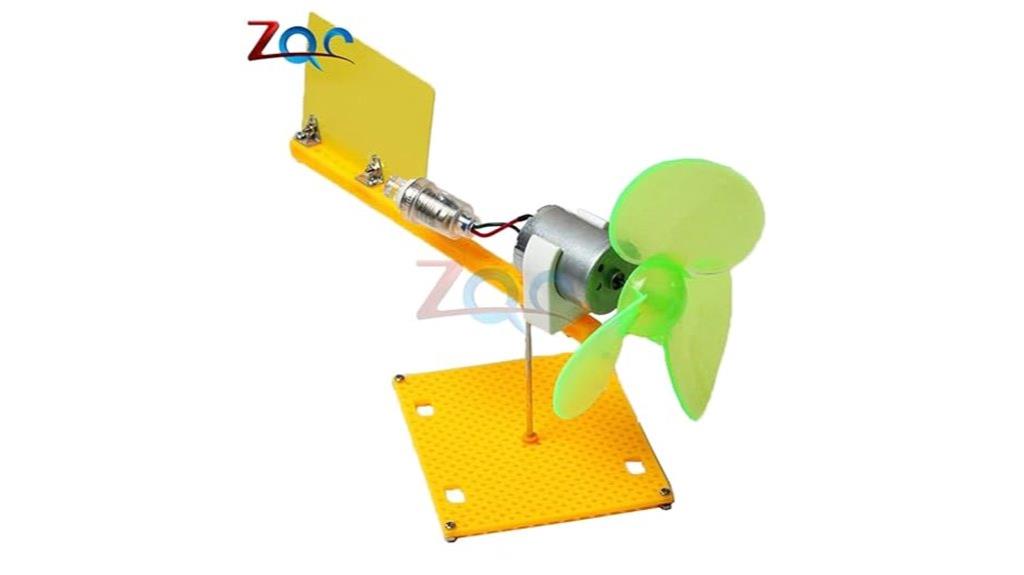
Micro Wind Turbines Generator DIY Kit stands out as an excellent choice for hobbyists, students, and educators enthusiastic to explore renewable energy through hands-on projects. This kit includes a small DC motor, blades, an LED, and a holder, all unassembled, making it perfect for learning wind turbine mechanics. Its compact size—about 20cm by 13.5cm by 9cm—fits well on rooftops or small spaces. The generator can produce DC output from 0.1V to 18V at speeds ranging from 200 to 6000 RPM. It provides practical experience in small-scale power generation, ideal for experiments, demonstrations, or DIY renewable energy setups.
Best For: hobbyists, students, and educators interested in hands-on renewable energy projects and small-scale wind turbine experimentation.
Pros:
- Includes all necessary components for DIY assembly, promoting practical learning.
- Compact size suitable for small spaces or rooftop installation.
- Wide electrical output range (0.1V to 18V) ideal for various small power applications.
Cons:
- Assembly required may be challenging for beginners without prior experience.
- Limited power output suitable mainly for educational purposes or very small devices.
- Mechanical parts may require careful handling to ensure proper alignment and performance.
Micro-Wind Turbines Generators Portable Power Generators

Portable micro-wind turbine generators are perfect for educators, students, and outdoor enthusiasts who want a hands-on way to learn about renewable energy. These compact DIY kits let you assemble small turbines that generate electricity from moving wind or water. You connect the turbine’s voltage regulator to a USB port, then place it in streams of high flow to produce power. Designed for safety and easy use, they teach fundamental motor and electrical principles while providing practical experience. With output voltages from 0.1 to 6V and currents up to 0.3A, they’re versatile tools for experiments, demonstrations, and outdoor learning adventures.
Best For: educators, students, and outdoor enthusiasts seeking a hands-on, educational experience in renewable energy and electrical principles.
Pros:
- Encourages active learning through assembly and experimentation.
- Portable and easy to set up in outdoor environments.
- Demonstrates wind energy conversion and motor operation effectively.
Cons:
- Requires manual assembly, which may be challenging for some users.
- Slight variations in color and minor measurement errors may occur.
- Limited power output suitable mainly for small experiments and demonstrations.
Wind Turbines 600W DC 12V Generator Kit with 5 Blades

If you’re looking to supplement your home energy system or power remote locations, the 600W DC 12V Generator Kit with 5 blades offers an efficient solution. Its precision jetting moulding technology optimizes aerodynamic and structural design, boosting wind energy capture and increasing annual output. The patented permanent magnet rotor alternator reduces torque resistance, ensuring reliable operation and better blade matching. Made from durable die-casting aluminum with UV and acid rain resistance, this compact turbine features double bearings for less vibration, low starting wind speed, and high wind resistance. It’s perfect for hybrid systems, street lamps, farms, or remote areas across Europe and the US.
Best For: homeowners, remote area developers, and hybrid energy system users seeking an efficient, durable wind power solution for supplemental or remote energy needs across Europe and the US.
Pros:
- Optimized aerodynamic and structural design with precision jetting moulding technology for increased wind energy capture.
- Durable construction using die-casting aluminum with UV and acid rain resistance, ensuring longevity.
- Low starting wind speed and high wind resistance, suitable for various environments and applications.
Cons:
- May require technical knowledge for installation and integration into existing systems.
- Performance dependent on local wind conditions; less effective in low-wind areas.
- Limited to 600W output, which might not meet higher energy demands.
Micro Vertical Wind Turbines for DIY Power Generation

For DIY enthusiasts and educators seeking an accessible way to generate small-scale wind power, micro vertical wind turbines are an excellent choice. These compact, lightweight kits (around 60g) feature a 360° rotatable design, automatically adjusting to wind direction for maximum efficiency. With a diameter of 100mm, they operate smoothly at wind speeds as low as 5.5 m/s, producing up to 0.55W of power. Perfect for educational projects and experiments, they demonstrate fundamental wind energy principles while being easy to assemble and portable. Their quiet operation and ability to light LEDs make them practical tools for hands-on learning about renewable energy.
Best For: DIY enthusiasts, educators, and students interested in hands-on learning and small-scale renewable wind energy projects.
Pros:
- Easy to assemble and adjust, making it suitable for beginners and educational settings
- Compact, lightweight, and portable for use in classrooms, experiments, and outdoor demonstrations
- Quiet operation with efficient power generation capable of lighting LEDs, demonstrating practical energy conversion
Cons:
- Limited power output (up to 0.55W), not suitable for large-scale energy needs
- Operates optimally at light wind speeds (around 5.5 m/s), less effective in very calm or strong winds
- Requires manual assembly and alignment, which may be challenging for very young children or novices
Non Power Roof Ventilator Stainless Steel 304
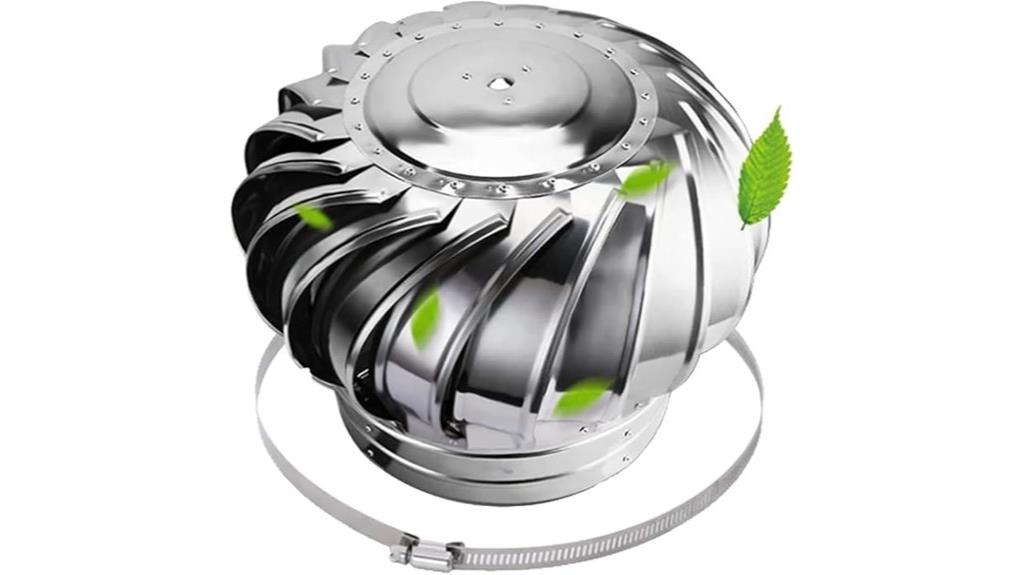
The Non Power Roof Ventilator Stainless Steel 304 stands out as an ideal choice for those seeking a durable, eco-friendly ventilation solution without relying on electricity. Made from high-quality 304 stainless steel, it offers strong resistance to force and pressure, ensuring long-lasting performance. Its galvanized bearings provide excellent support, preventing deformation. Capable of high-speed rotation without noise, it withstands wind speeds up to 200 km/h. Available in sizes from 75mm to 400mm, it’s versatile for various applications like roofs, chimneys, or industrial spaces. This vent operates automatically, promoting energy efficiency and reducing risks associated with electrical systems.
Best For: businesses and property owners seeking a durable, eco-friendly ventilation solution that operates without electricity in industrial, agricultural, or commercial settings.
Pros:
- Made of high-quality 304 stainless steel for excellent strength and durability
- No electricity required, promoting energy efficiency and safety
- Capable of withstanding high wind speeds up to 200 km/h without noise
Cons:
- Limited size options may not fit all specific installation needs
- Manual installation may require some technical skill
- Not suitable for environments requiring powered or adjustable ventilation systems
Stainless Steel Non-Power Roof Ventilator, Exhaust Wind Turbines Cap, 8-12 Inch Vent

Designed for durability and reliable performance, the Stainless Steel Non-Power Roof Ventilator is ideal for those seeking a maintenance-free solution to improve ventilation. Made from thickened stainless steel 201, it resists rust and offers a long service life. Its galvanized support frame and high-quality ball bearings guarantee smooth, energy-free operation, even under strong pressure. The turbine rotates naturally using wind and thermal convection, effectively exhausting stale indoor air. Suitable for chimneys, farms, factories, houses, and warehouses, it can be installed on various slopes and surfaces. With an 8-12 inch diameter, it provides versatile, high-efficiency ventilation across different environments.
Best For: Homeowners, farm operators, factory managers, and warehouse owners seeking durable, maintenance-free ventilation solutions.
Pros:
- Made from thickened stainless steel 201, ensuring rust resistance and longevity
- Operates smoothly without power, utilizing natural wind and thermal convection
- Easy to install on various slopes and surfaces, suitable for multiple environments
Cons:
- Dependent on wind and temperature conditions for optimal performance
- May produce some noise during rotation in strong winds
- Limited to 8-12 inch sizes, which might not suit very large or specialized exhaust needs
Roof Wind Turbines Cap Vent
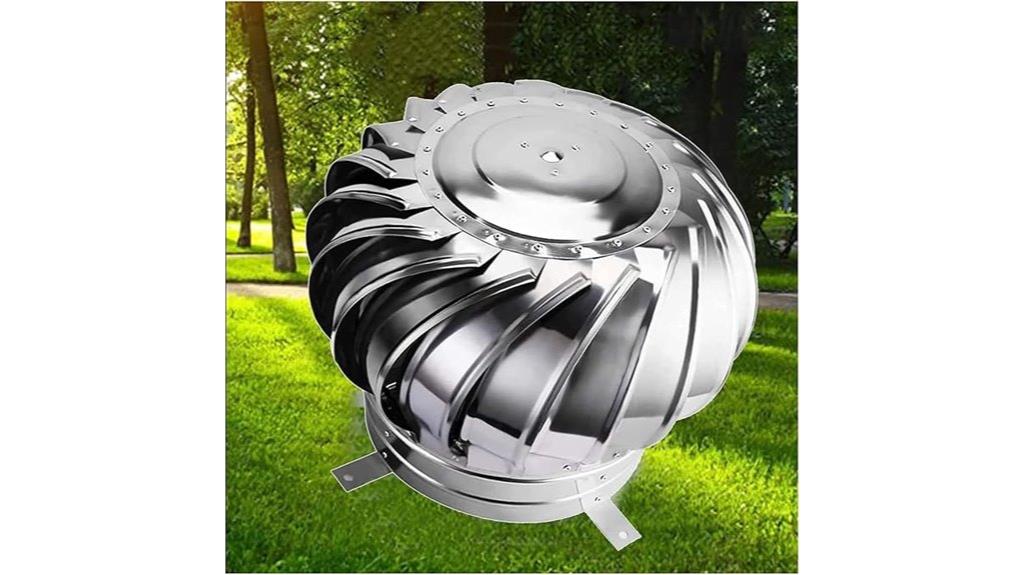
Looking for a reliable way to improve indoor air quality without relying on electricity? The Roof Wind Turbines Cap Vent is a durable, energy-efficient solution. Made from stainless steel with a galvanized frame, it features weather-resistant blades and high-speed ball bearings, ensuring long-lasting performance. Designed for easy installation on sloped roofs, it uses natural wind and thermal convection to vent hot, stale air outdoors silently. Suitable for various settings, from residential to industrial, it helps prevent debris clogging and reduces noise. With sizes from 4 to 12 inches, this cap vent promotes continuous airflow, enhancing indoor comfort without energy consumption.
Best For: homeowners, facility managers, and industrial operators seeking reliable, energy-free ventilation solutions for roofs and indoor spaces.
Pros:
- Durable construction with stainless steel and galvanized support frame for long-lasting performance
- Uses natural wind and thermal convection, eliminating energy costs and reducing environmental impact
- Easy to install on various roof slopes and compatible with multiple building types
Cons:
- Limited to sizes up to 12 inches, which may not suit very large ventilation needs
- Installation may require specific tools or expertise for optimal sealing and performance
- Dependence on wind conditions could result in variable ventilation efficiency in very calm weather
Pikasola 1000W Wind Turbine Generator Kit

If you’re seeking a compact yet powerful wind turbine for hybrid solar-wind setups, the Pikasola 1000W Wind Turbine Generator Kit stands out. It’s designed for 24V systems and suits marine, RV, home, and windmill applications. Its nylon carbon fiber blades are lightweight, waterproof, and corrosion-resistant, starting efficiently at low wind speeds. The three-phase permanent magnet motor with high-performance NdFeB magnets guarantees high efficiency and low vibration. The adjustable yaw system and aerodynamic tail fin optimize wind capture, while the durable aluminum alloy body guarantees longevity. At 41.3 inches long and weighing 64 pounds, it’s a robust choice for small space power generation.
Best For: individuals seeking a compact, efficient wind turbine for hybrid solar-wind energy systems suitable for marine, RV, home, or small windmill setups.
Pros:
- Starts efficiently at low wind speeds, maximizing energy capture
- Lightweight, waterproof, and corrosion-resistant nylon carbon fiber blades for durability in various environments
- Adjustable yaw system and aerodynamic tail fin optimize wind alignment and performance
Cons:
- Relatively heavy at 64 pounds, which may require sturdy mounting solutions
- Limited to 24V systems, not suitable for higher voltage applications
- Slightly larger dimensions may require more installation space than ultra-compact models
DARZYS Roof Wind Turbines Cap Vent

The DARZYS Roof Wind Turbines Cap Vent stands out as an ideal choice for homeowners and small business operators seeking reliable, quiet ventilation. It uses temperature differences and air convection to rotate effortlessly, expelling stale indoor air and promoting circulation. Its special design allows rapid exhaust of roof air, making it perfect for chimneys and infrequently used vents. Even during rainy days, it operates smoothly without rainwater disturbance. Equipped with a noiseless device, it maintains a quiet environment. Made from durable materials, it’s built to resist rust and weather, ensuring long-lasting performance across various applications, including farms, warehouses, and residential roofs.
Best For: homeowners and small business operators seeking quiet, reliable roof ventilation for residential, commercial, or agricultural buildings.
Pros:
- Utilizes natural temperature differences and air convection for effortless rotation and effective ventilation.
- Operates smoothly during rainy days without rainwater disturbance, ensuring continuous airflow.
- Made from durable, rust-resistant materials that withstand harsh weather and provide long-lasting performance.
Cons:
- May require professional installation to ensure optimal performance and sealing.
- Designed primarily for light commercial and residential use; may not suit heavy industrial applications.
- Limited aesthetic options, as the focus is on functionality and durability rather than appearance.
Roof Wind Turbines Cap Ventilator, 4-12 Inch, Unpowered Rainproof Rotating Vent
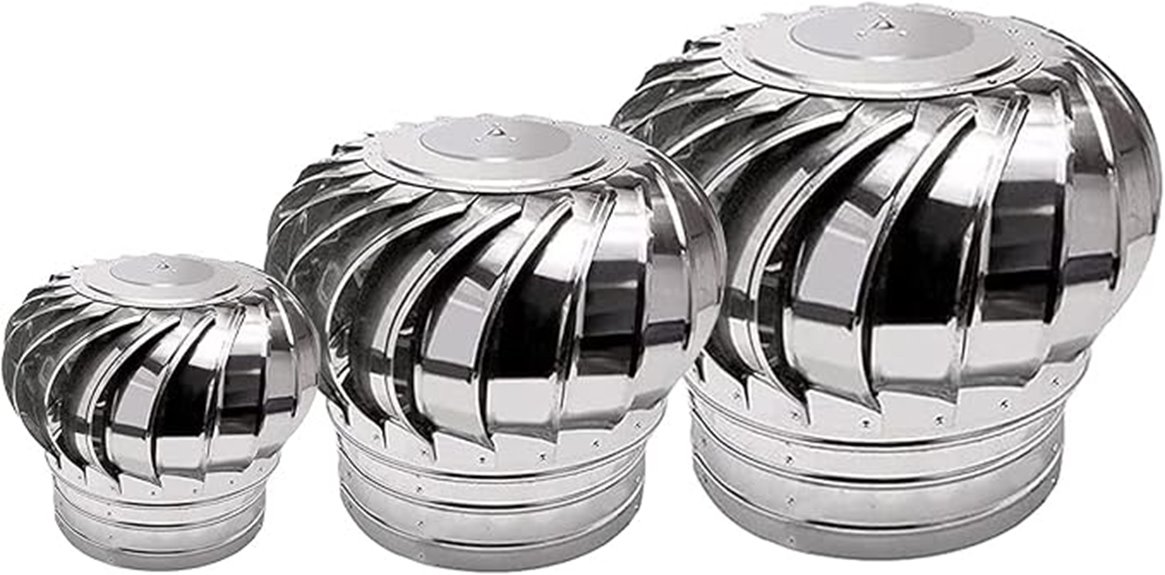
For those seeking an energy-efficient way to ventilate chimneys and exhaust air without relying on power, the Roof Wind Turbines Cap Ventilator offers a reliable solution. Made of durable stainless steel, it features a rotating chimney cover that turns with the wind, boosting airflow naturally. Its rainproof design protects against weather elements, ensuring continuous ventilation. Available in sizes from 4 to 12 inches, it’s easy to install with all necessary accessories included. This no-power, energy-saving turbine enhances chimney performance while preventing wind intrusion, making it perfect for rooftop ventilation, air outlets, or chimneys needing reliable, maintenance-free airflow.
Best For: homeowners and building managers seeking a maintenance-free, energy-efficient ventilation solution for chimneys and roof outlets.
Pros:
- No power required, saving energy and reducing operational costs
- Rotates with wind to naturally enhance airflow and ventilation efficiency
- Durable stainless steel construction offers corrosion resistance and long-term durability
Cons:
- Effectiveness depends on wind availability; minimal wind may reduce rotation and airflow
- Limited sizes may not fit very large or irregular chimney outlets
- Installation may require precise sizing and positioning to maximize performance
Factors to Consider When Choosing Micro‑Wind Turbines for Rooftops

When choosing a micro-wind turbine for your rooftop, I consider factors like wind speed to guarantee it can produce enough energy. Size, material durability, and noise levels also matter to fit your space and keep things quiet. Finally, I look at how easy it is to install and maintain to make sure it’s a practical, long-term solution.
Wind Speed Compatibility
Choosing a micro-wind turbine that matches your area’s wind speeds is crucial for maximizing energy output. You need to verify the turbine’s rated wind speed aligns with the typical wind conditions where you plan to install it. If your location experiences gentle breezes, look for turbines that operate efficiently at low wind speeds, such as 5-6 m/s. It’s also important to check the turbine’s cut-in wind speed—the minimum needed to generate power—and confirm it matches your local wind environment. Opt for turbines with adjustable or broad operational wind speed ranges, like 3 to 6000 RPM, to handle variable rooftop winds. For windier regions, choose turbines designed for higher wind speeds, up to 200 km/h, to ensure durability and safety.
Size and Space Needs
To guarantee your rooftop micro-wind turbine fits properly and performs efficiently, you need to carefully consider its size and space requirements. First, verify the blade diameter fits within your available rooftop space to prevent installation issues. Check the overall height and dimensions to avoid interference with existing structures or equipment. It’s also important to evaluate the rotor size relative to your roof’s size, maximizing energy capture without overcrowding. Don’t forget to account for clearance around the turbine, which is vital for ideal wind flow and easy maintenance access. Lastly, aim for a size that balances your power needs with your rooftop’s physical constraints. Properly evaluating these factors helps you select a turbine that operates safely and efficiently within your space.
Material Durability
The materials used in micro-wind turbines play a pivotal role in guaranteeing they withstand the harsh outdoor conditions on rooftops. Choosing materials like stainless steel and die-cast aluminum is vital because they resist corrosion and environmental stress, which are common challenges outdoors. High-quality stainless steel, especially grades like 304 or 201, offers excellent strength and rust resistance, helping turbines last longer. Protective coatings and galvanized bearings prevent wear caused by moisture, wind, and debris, reducing maintenance needs. Additionally, materials with high-temperature resistance and UV protection extend the lifespan, especially in sunny, fluctuating climates. Prioritizing durable, weather-resistant materials not only guarantees reliable performance but also minimizes ongoing repairs, making your micro-wind turbine a sustainable, long-term energy solution.
Noise and Vibration Levels
Micro-wind turbines are designed to operate quietly, typically producing noise levels comparable to a soft conversation, which makes them suitable for residential rooftops. Most turbines generate around 40-60 decibels, minimizing disturbance to residents and neighbors. Vibration levels are usually minimal thanks to balanced blade design and high-quality bearings, which help reduce mechanical noise and structural stress. Excessive vibrations can cause early wear, so choosing turbines with dampening features or sturdy mounts is essential for longevity. Turbines with smooth, balanced blades tend to produce less vibration and noise, ensuring stable operation. Proper installation, including secure mounting and correct alignment, also plays a key role in minimizing vibrations and noise pollution. Overall, selecting quiet and well-balanced turbines enhances both comfort and operational durability.
Installation and Maintenance
Installing a micro-wind turbine properly is key to ensuring its reliable operation and longevity. Secure it firmly to withstand high wind speeds, often up to 200 km/h for stainless steel models. Proper installation minimizes vibrations and reduces the risk of damage. Maintenance involves regular cleaning of blades and bearings to prevent debris buildup and keep the turbine running smoothly. Periodic inspections of components like bearings and support frames help catch wear or corrosion early, extending the lifespan. Ensuring easy access for maintenance tasks is essential, as it reduces downtime and makes repairs more efficient. Choosing turbines built with durable, corrosion-resistant materials like stainless steel can considerably cut down on upkeep, especially in outdoor rooftop environments exposed to the elements.
Frequently Asked Questions
How Much Energy Can a Typical Rooftop Micro-Wind Turbine Generate Annually?
You’re wondering how much energy a typical rooftop micro-wind turbine can generate annually. I’ve found that it usually produces between 100 and 400 kWh per year, depending on factors like wind speed, turbine size, and location. While this might not power your entire home, it can markedly reduce your energy bills and carbon footprint. Proper installation and choosing the right turbine are key to maximizing your energy output.
What Are the Noise Levels Produced by Rooftop Micro-Wind Turbines?
Imagine a whispering breeze dancing around your rooftop— that’s how quiet micro-wind turbines are. Usually, they produce noise levels between 40 to 60 decibels, comparable to a soft conversation or rustling leaves. I find that modern designs and proper placement help keep noise minimal, so you’ll hardly notice them. This means harnessing wind power without disturbing the peace of your home or neighborhood.
How Do Weather Conditions Affect Micro-Wind Turbine Efficiency?
Weather conditions play a vital role in my micro-wind turbine’s efficiency. Strong winds boost energy output, but too much can damage the blades. Calm days limit power generation, and turbulent or unpredictable weather can cause instability. I always check local forecasts and choose turbines designed for specific wind conditions. Proper placement and maintenance help guarantee consistent performance, even when weather isn’t ideal.
Are Rooftop Micro-Wind Turbines Suitable for Urban Environments?
Imagine stepping into the future, but here we are discussing rooftop micro-wind turbines in urban environments. I believe they can be suitable if your building’s location has consistent wind flow and minimal obstructions. They’re a smart way to generate renewable energy in small spaces. However, I’d recommend evaluating local wind conditions and city regulations first to guarantee they’ll work efficiently and safely for your specific environment.
What Maintenance Is Required to Keep Turbines Functioning Optimally?
When it comes to maintaining turbines, I keep an eye on their blades and moving parts regularly. I clean debris, check for corrosion, and guarantee bolts are tight. I also monitor performance to catch any drops in energy output early. Routine inspections every few months help me spot issues before they become costly. Proper maintenance keeps my turbines running smoothly and maximizes their efficiency over time.
Conclusion
Imagine your rooftop as a tiny wind farm, each turbine a diligent dancer spinning in harmony with the breeze. Choosing the right micro-wind turbine transforms this dance into a powerful symphony of energy, turning small spaces into thriving energy hubs. With the right gear, you’re not just capturing wind—you’re harnessing nature’s breath to fuel your world, making your rooftop a vibrant, sustainable powerhouse that sings with the wind’s song.





